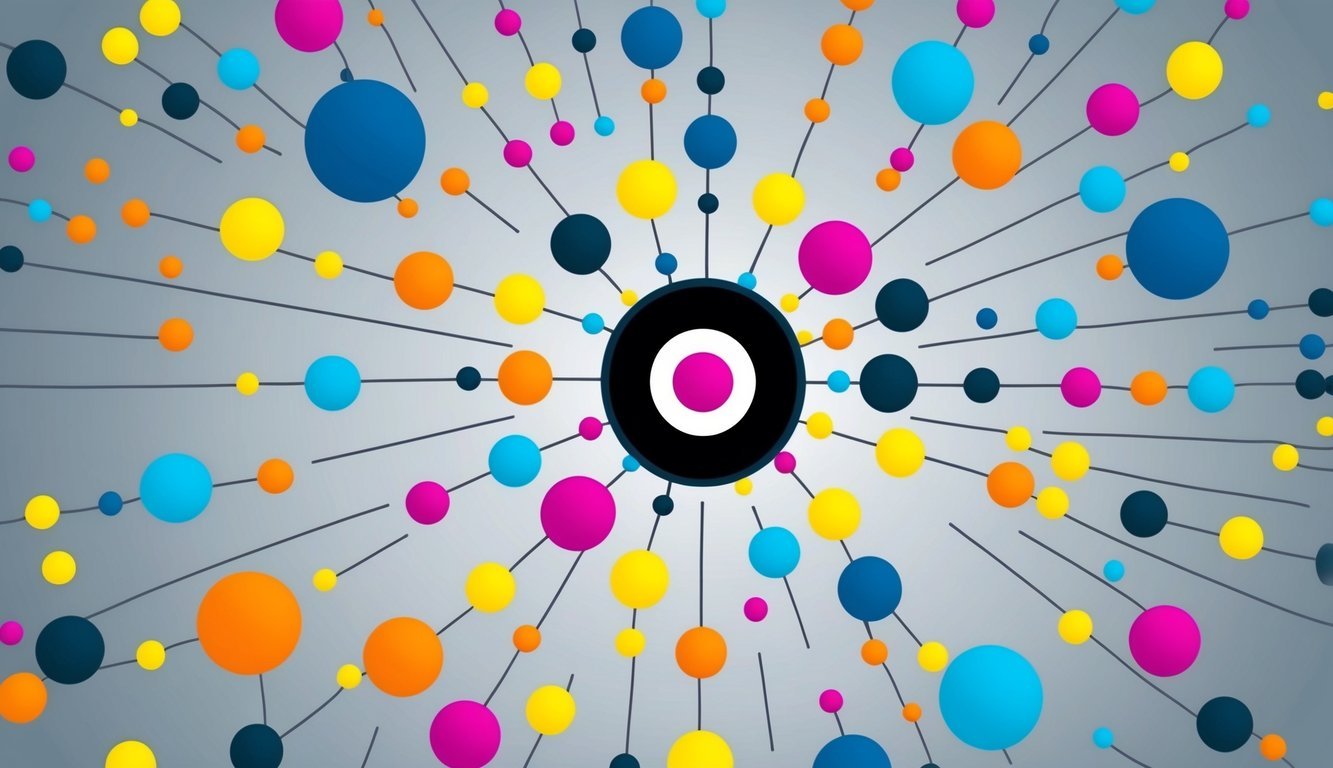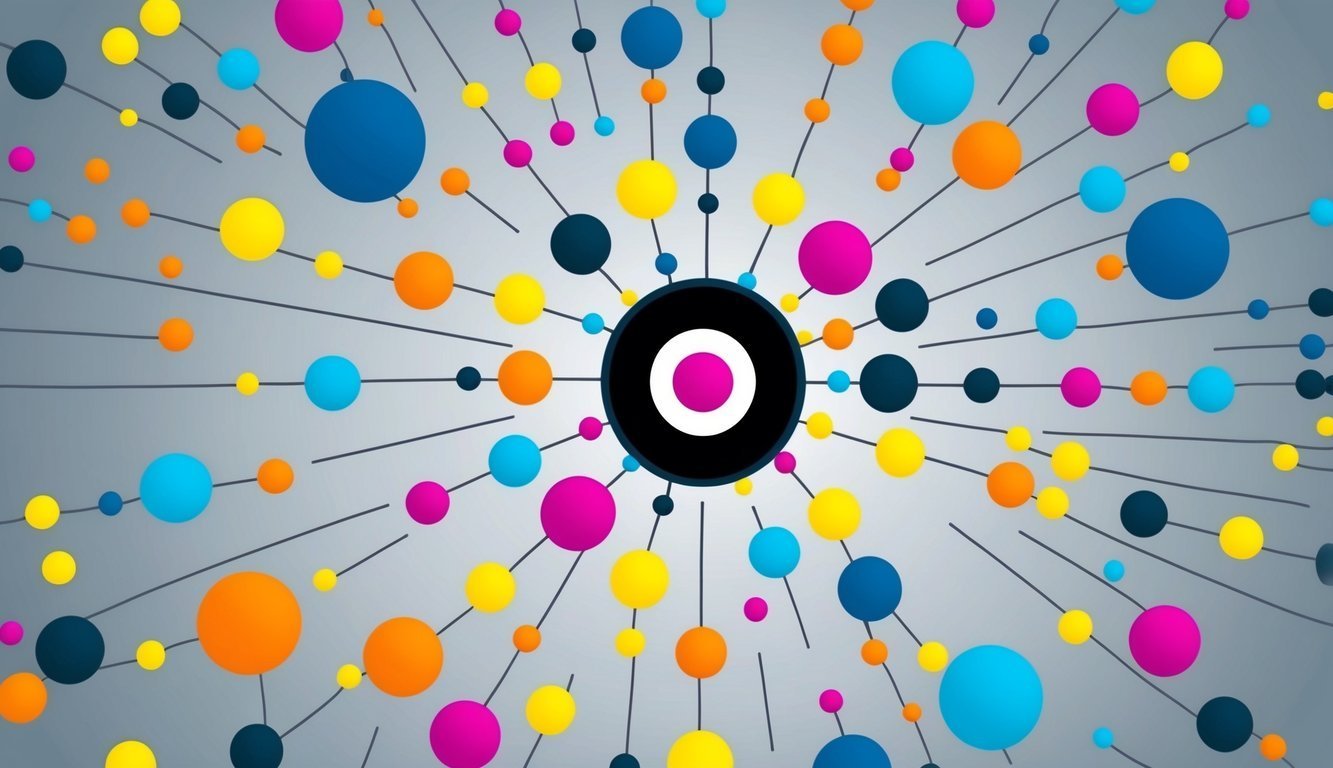Polkadot is a new type of blockchain network that aims to solve some big problems in the crypto world. Polkadot lets different blockchains talk to each other, making it easier to move data and assets between them. This is a big deal because most blockchains can’t do this on their own.

The DOT token is the fuel that makes Polkadot run. You can use it to vote on changes to the network, pay fees, and help keep the system secure. It’s not just another cryptocurrency – DOT plays a key role in how Polkadot works.
Polkadot was made to be fast, cheap to use, and able to grow as more people join. It’s trying to fix issues that older blockchains like Bitcoin and Ethereum have, like being slow or expensive when lots of people use them at once.
Key Takeaways
- Polkadot connects different blockchains, allowing them to work together seamlessly.
- The DOT token is used for governance, fees, and securing the Polkadot network.
- You can build your own blockchain or app on Polkadot, making it a flexible platform for developers.
Understanding Polkadot’s Architecture
Polkadot’s design aims to solve big problems in blockchain. It uses a special setup to make things work better together. Let’s look at the key parts that make Polkadot tick.
Relay Chain and Parachains
The relay chain is Polkadot’s main chain. It’s like the boss of the whole system. This chain makes sure everything is secure and runs smoothly.
Parachains are separate blockchains that connect to the relay chain. They’re like team members with special jobs. Each parachain can do its own thing, but they all work together.
You can think of parachains as puzzle pieces. They fit into Polkadot’s big picture, but each has its own shape and purpose. This setup helps Polkadot handle more tasks at once.
Consensus Mechanism
Polkadot uses a special way to agree on things. It’s called Nominated Proof-of-Stake (NPoS). This method helps keep the network safe and fair.
In NPoS, you can choose to be a validator or nominator. Validators check transactions and add new blocks. Nominators pick validators they trust and back them up.
This system is smart because it lets more people take part. It also uses less energy than some other methods. The result? A faster, more eco-friendly blockchain.
Interoperability and Cross-Chain Communication
Polkadot shines when it comes to helping different blockchains talk to each other. It’s like a universal translator for blockchain languages.
The relay chain acts as a hub. It helps messages and value move between parachains. This means you can send data or tokens from one chain to another easily.
Bridges are another cool feature. They let Polkadot connect with outside blockchains like Ethereum. This opens up a world of possibilities for sharing info and assets across different networks.
DOT Token: More Than Just a Cryptocurrency
DOT is the heart of the Polkadot network. It’s a versatile token that plays many important roles beyond just being a digital currency.
Staking and Validation
When you stake DOT, you help keep the Polkadot network secure. You can become a validator or nominator to earn rewards. Validators run nodes to process transactions, while nominators back validators with their DOT.
To become a validator, you need technical skills and a lot of DOT. But don’t worry if that’s not for you. As a nominator, you can still earn rewards by picking good validators to support.
The cool thing about Polkadot is that it can handle over 1,000 transactions per second. That’s way faster than Bitcoin or Ethereum!
Governance and Voting
Your DOT gives you a say in how Polkadot grows. You can vote on big decisions like network upgrades or treasury spending. It’s like being part of a digital democracy!
Here’s how it works:
- Propose changes
- Discuss ideas
- Vote on proposals
- See results in action
The more DOT you have, the stronger your vote. But even with a small amount, you can join in and make your voice heard.
Price and Trading
DOT’s price can go up and down a lot. It’s traded on many big crypto exchanges. You can buy, sell, or trade it for other cryptocurrencies.
Some factors that affect DOT’s price:
- Polkadot network growth
- New projects joining Polkadot
- Overall crypto market trends
Remember, crypto prices can be very unpredictable. Only invest what you can afford to lose. It’s smart to do your own research before buying any DOT.
You can track DOT’s price on websites like CoinGecko or CoinMarketCap. These sites also show trading volume and market trends.
The Economic Landscape of Polkadot

Polkadot’s economy revolves around its native token DOT and innovative funding mechanisms. The project aims to solve scalability issues plaguing other blockchains while creating new opportunities for developers and investors.
Funding Projects and Initial Coin Offering
Polkadot kickstarted its journey with a successful Initial Coin Offering (ICO). This funding round helped gather resources for development and community building.
The DOT token plays a crucial role in the ecosystem. You can use it for:
- Governance voting
- Staking
- Bonding to connect parachains
Polkadot’s unique approach allows new projects to secure a parachain slot through crowd loans. This gives you a chance to support promising ideas and potentially earn rewards.
Scalability Solutions and Competitive Edge
Polkadot tackles scalability head-on with its multi-chain architecture. You’ll find this approach different from Bitcoin or Ethereum’s single-chain model.
Key benefits include:
- Faster transaction processing
- Lower fees
- Increased network capacity
Polkadot’s interoperability focus sets it apart. You can easily move assets and data between different blockchains connected to the network. This creates a more connected and efficient crypto ecosystem.
The project’s Nominated Proof-of-Stake consensus mechanism offers an energy-efficient alternative to Bitcoin’s Proof-of-Work. This aligns with growing environmental concerns in the crypto space. The Nominated Proof-of-Stake mechanism allows validators to be selected based on their stake, which not only reduces energy consumption but also enhances the network’s overall security and sustainability. As more projects seek to address these environmental issues, the demand for innovative consensus mechanisms is rising, leading to developments like the avalanche blockchain platform overview. This platform further exemplifies the shift towards more efficient and scalable blockchain solutions, providing an alternative that meets the needs of a rapidly evolving industry.
Building on Polkadot
Polkadot offers cool tools for developers to create blockchain projects. You can build custom blockchains or decentralized apps that work across different networks.
Substrate Development Framework
Substrate is Polkadot’s go-to toolkit for making blockchains. It’s like LEGO for blockchain – you pick the parts you need and snap them together.
With Substrate, you can:
- Create custom blockchains fast
- Use pre-made modules for common features
- Easily connect your chain to Polkadot
Substrate lets you focus on what makes your blockchain special. You don’t have to worry about the basic stuff – it’s all there for you to use.
Creating Decentralized Applications
Building decentralized applications (dApps) on Polkadot is pretty sweet. You get to tap into a whole network of blockchains.
Here’s what you can do:
- Make dApps that work across different chains
- Use smart contracts to automate tasks
- Access a big pool of users from various networks
Your dApps can talk to other blockchains in the Polkadot ecosystem. This means more features and a bigger reach for your project.
Polkadot’s tools make it easier to build complex dApps. You can focus on making your app awesome instead of worrying about the technical stuff.
Frequently Asked Questions

People ask lots of questions about Polkadot and its DOT token. Let’s clear up some common stuff about how it’s used, where the price might go, and why it’s getting so much attention.
How’s Polkadot (DOT) used in the crypto scene?
DOT is the main token for the Polkadot network. You can use it to vote on changes, secure the network through staking, and connect new chains. It’s like the fuel that keeps Polkadot running smoothly.
Got any price predictions for Polkadot’s future?
It’s tough to say for sure where DOT’s price will go. Crypto prices can change fast. But some folks think Polkadot could grow as more projects use its network. Just remember, no one can predict prices 100%.
Can you mine DOT, or what’s the deal there?
You can’t mine DOT like Bitcoin. Instead, Polkadot uses a system called proof-of-stake. You can earn rewards by staking your DOT tokens to help secure the network.
Think Polkadot’s a solid investment or nah?
That’s a tricky question. Polkadot has some cool tech and big goals. But all crypto investments are risky. It’s smart to learn more and only invest what you can afford to lose.
Are DOT and Polkadot really just two names for the same thing?
Not exactly. Polkadot is the name of the whole network. DOT is the native token used on that network. Think of Polkadot as the system and DOT as the currency it uses.
Why’s everyone buzzing about Polkadot these days?
People are excited about Polkadot because it tries to solve big problems in crypto. It aims to connect different blockchains and make them work together better. This could be a game-changer if it takes off.





